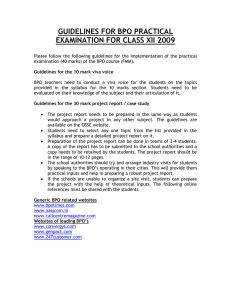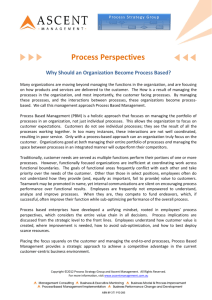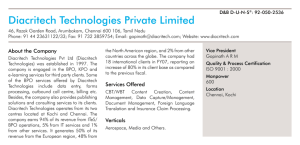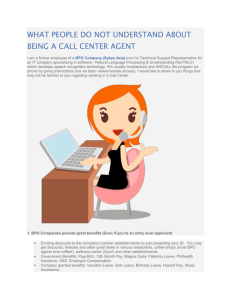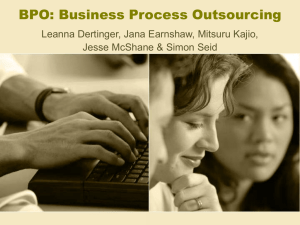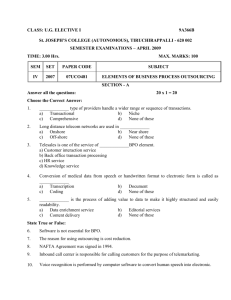Nine Keys to World-Class BPO: An illustration of practice-focused research
advertisement
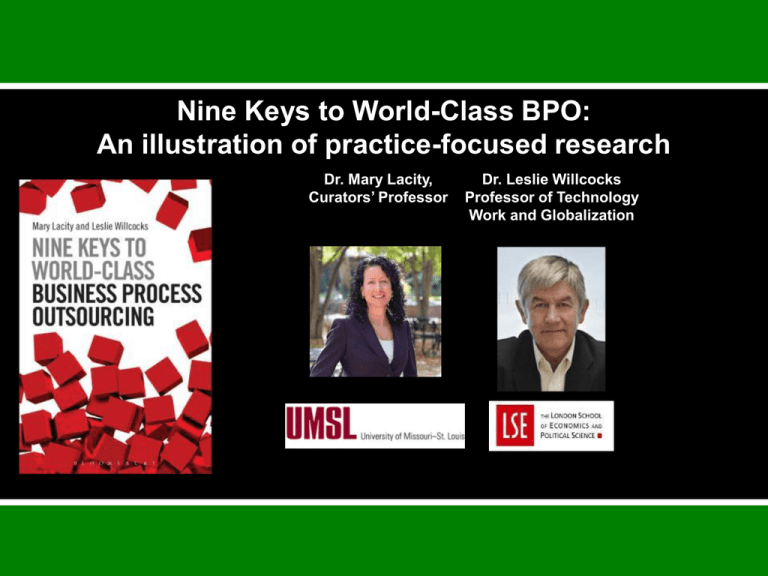
Nine Keys to World-Class BPO: An illustration of practice-focused research Dr. Mary Lacity, Curators’ Professor Dr. Leslie Willcocks Professor of Technology Work and Globalization Session Objective Demonstrate the fluid, emergent, iterative nature of our practice-based inquiries Research Question Design Data Collection Data Analysis Research Output Research Inspiration Board Influence Research Inspiration Board Data Analysis Research Output Influence Research Overview Based on the results of a five surveys, including a survey of 263 business process outsourcing (BPO) clients and 65 client-provider interviews, our research identifies nine practices associated with best-in-class BPO performance. Since book was published, we are deeply investigating one practice on technology called Robotic Process Automation; surveys & case studies & a book due October 10th! Sample Publications Refereed Journals: Lacity, M., and Willcocks, L. (2014), “Business Process Outsourcing and Dynamic Innovation,” Strategic Outsourcing: An International Journal, Vol. 7, 1, pp. 66-92. Winner, best paper award. Lacity, M. and Willcocks, L. (2013), “Beyond Cost Savings: Outsourcing Business Processes for Innovation,” Sloan Management Review, Vol. 54, 3, pp. 63-69. Lacity, M., and Willcocks, L. (2014), “Nine Practices for Best-in-Class BPO Performance,” MIS Quarterly Executive, Vol. 13, 3, pp. 131-146. Revise and Resubmit: Lacity, M., (2015), “Conflict Resolution in Business Services Outsourcing Relationships”, Journal of Information Technology. Non-refereed Journals: Published multiple smaller articles in Pulse Magazine, Professional Outsourcing Magazine, and Outlook Magazine Research Context: Sourcing Back Office Services F&A strategy Performance mgmt. HR design Regulatory & compliance Internal audit Budget/forecasting Fixed assets/ capital budget Treasury & risk mgmt. Mgmt reporting & analysis Training & development Recruitment & selection Compensation Benefits Payroll Employment data mgmt. S2P strategy Spend data mgmt Strategic sourcing Vendor mgmt. Demand mgmt. Strategy Key processes Transactional services Day-to-day purchasing Customer service Accounts receivable Procurement systems Accounts Performance mgmt. Tax payable General accounting Transportation (Indirect materials) Manufacturing HR strategy Procurement Transactional BPO Full service BPO Finance & Accounting Biotechnology Human Resources Healthcare Vertical Specific BPO ITO Call Centers Applications maintenance Data centers Voice & Data Networks ERP Help desk Desktop Applications development IT strategy Source: Oracle Internal Training 7 BPO Performance Varies Cost savings/SLAs improved each year Business benefits/Innovations delivered High client satisfaction Cost savings delivered Meeting SLAs Good client satisfaction Marginal cost savings delivered Acceptable service performance Marginal client satisfaction No cost savings; costs increased Poor service performance Low client satisfaction Nine Keys Research Determinants of Outcomes Access to Everest Group’s BPO survey of 263 qualified BPO clients Nine Keys Research Determinants of Outcomes Survey identified 8 best-in-class practices: Practice 1. Focus on benefits beyond cost reduction Practice 2. Target strategic outcomes Practice 3. Adopt a partnership-based approach to governance Practice 4. Take a holistic approach to the scope of the BPO relationship Practice 5. Align the retained organization with the outsourced processes Practice 6. Drive strong transition, transformational and change management capabilities Practice 7. Contextualize data through domain expertise and analytics Practice 8. Emphasize the benefits of technology in the BPO relationship Nine Keys Research Determinants of Outcomes Qualitative Data Collected on BPO Relationships Number Number of of Key Relationships Informant Studied Interviews Context Financial & Accounting Services (FAO) Human Resources (learning, recruiting, etc.) (HRO) Legal Process (LPO) Procurement/Supply Chain Outsourcing Customer Care/ Call Center, Outsourcing Cloud services Total 8 18 3 6 6 11 5 10 6 12 4 8 32 65 Sample Cases BP, Microsoft Telstra, Kimberly Clark RadiantLaw, BT Givaudan, Synopsis TalkTalk, British Gas, iiNet Diesel Direct, Dana Foundation 12 Nine Keys Research Determinants of Outcomes 1. Focus on benefits beyond cost reduction Practice 2. Target strategic outcomes 3. Adopt a partnership-based approach to governance 4. Take a holistic approach to the scope of the BPO relationship 5. Align the retained organization with the outsourced processes 6. Drive strong transition, transformational and change management capabilities 7. Contextualize data through domain expertise and analytics 8. Emphasize the benefits of technology in the BPO relationship 1. Assign great leaderships pairs 2. Focus on business and strategic benefits beyond cost efficiencies 3. Adopt a partnering approach to governance 4. Align the retained organization, outsourced processes and provider staff 5. Drive strong transition, transformational and change management capabilities 6. Deploy domain expertise and business analytics 7. Resolve issues together and conflicts fairly 8. Prioritize and incentivize innovation 9. Use technology as enabler and accelerator of performance Nine Keys 3 practices launch the BPO relationship 3 practices keep the BPO relationship on track 3 practices explore new frontiers 1. Assign a Great Leadership Pair An effective leadership pair— one person from the client organization and a counterpart from the provider organization—must work collaboratively to implement the practices associated with best-in-class performance. 1. Assign a Great Leadership Pair TEN ATTRIBUTES OF EFFECTIVE LEADERSHIP PAIRS 1. Focus on the future 2. Transparent 3. Problem solve 4. Put the customer first 5. Spirit of togetherness 6. Clout 7. Action-oriented 8. Trustworthy 9. Empathetic 10. Chemistry with counterpart 7. Use technology as an enabler and accelerator of performance Onsite Onshore Offshore Automate Service Transformation Through Automation Dr. Mary Lacity, Curators’ Professor Copyright © Mary C. Lacity 2015 18 What is Robotic Process Automation? Software that automates a process the way a human does, by logging on and off systems Systems of Record “Knowledge” Worker “Robotic” Worker Copyright © Lacity, Willcocks, Craig 2015 19 Three Case Studies # processes automated 35% of back office (15 core processes) 35% of back office 14 core processes # RPA transactions per month 400,000 to 500,000 1 million 120,000 Copyright © Lacity, Willcocks, Craig 2015 Business Value Faster delivery Better service quality Higher compliance Unbeatable scalability Strategic enablement FTE avoidance FTE redeployment FTE savings ROI 650% to 800% 3YR 200% 1YR 30% per process 9. Prioritize and Incentivize Effec ve Leadership Innovation Pair Innovation Effects (t +2) Least Effec ve Most Effec ve Effec ve Incenting Innovation Productivity targets Innovation days Gainsharing-project level Delivering Innovations Acculturation Inspiration Funding Injection Innovation Effects (t +1) Innovation Effects (t) Operational efficiency Process effectiveness Strategic impact Threat of competition Special governance Innovation funds Benchmarking Gainsharing–relationship level Painsharing Figure 10.1 Nine Keys 1. Assign great leaderships pairs 2. Focus on business and strategic benefits beyond cost efficiencies 3. Adopt a partnering approach to governance 4. Align the retained organization, outsourced processes and provider staff 5. Drive strong transition, transformational and change management capabilities 6. Deploy domain expertise and business analytics 7. Resolve issues together and conflicts fairly 8. Prioritize and incentivize innovation 9. Use technology as enabler and accelerator of performance Session Objective Demonstrate the fluid, emergent, iterative nature of our practice-based inquiries Research Question Design Data Collection Data Analysis Research Output Research Inspiration Board

